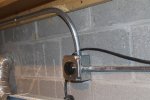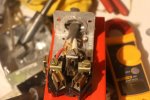winnie
Senior Member
- Location
- Springfield, MA, USA
- Occupation
- Electric motor research
As Little Bill has said, the most likely problem is something loose at the receptacle, and replacing the receptacle and dryer cord will very likely completely fix the problem.
The OP opened this thread with a question about some defect in the dryer causing the receptacle or cord to fail.
While this scenario is unlikely IMHO it would show up as excessive current flow on the dryer circuit. IMHO this is best tested a convenient location where there is access to individual conductors for a clamp on current sensor. This location might very well be the panel where the conductors are exposed, but there is lots of other junk there.
-Jon
The OP opened this thread with a question about some defect in the dryer causing the receptacle or cord to fail.
While this scenario is unlikely IMHO it would show up as excessive current flow on the dryer circuit. IMHO this is best tested a convenient location where there is access to individual conductors for a clamp on current sensor. This location might very well be the panel where the conductors are exposed, but there is lots of other junk there.
-Jon



